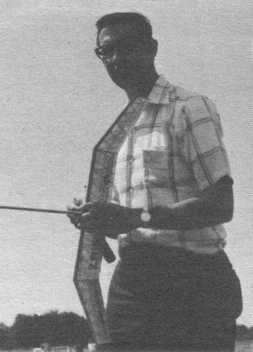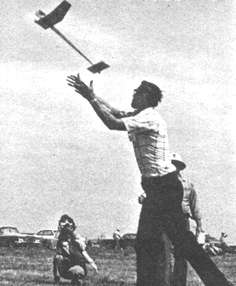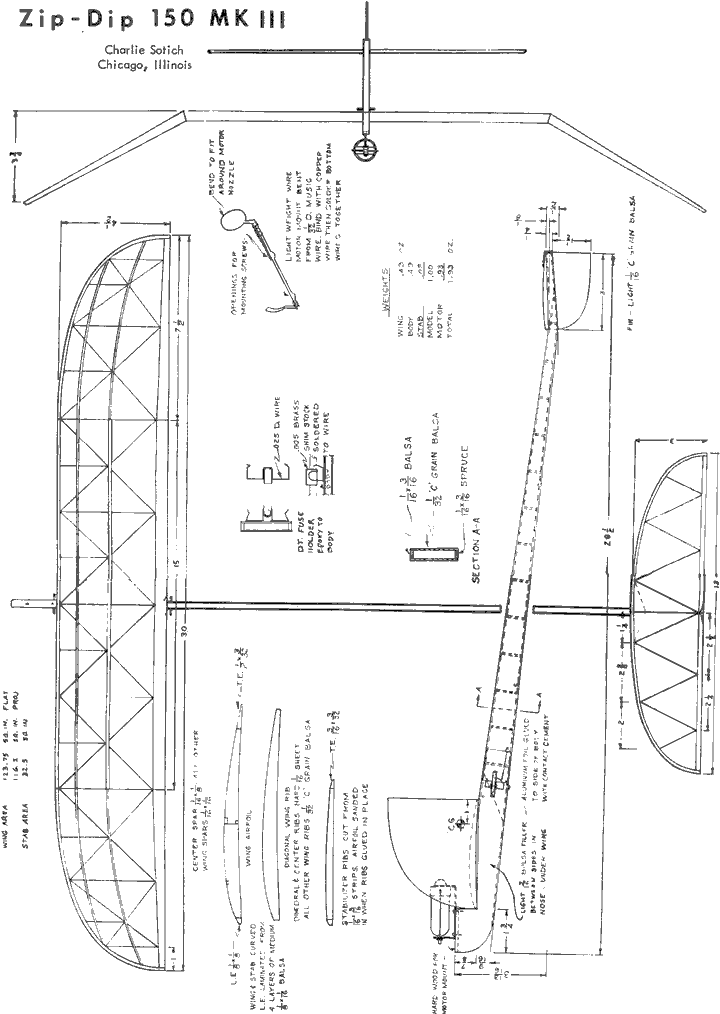|
|
|
|||
|
|
||||
|
|
||||
| Plan: Zip-Dip 150 Mk III | ||||
|
|
HOME | SITE MAP | FORUM | CONTACT |
|
||
|
ABOUT | MOTORS | MODELS | ARCHIVE | HISTORY | STORE | FAQ | LINKS
|
|
|
|
||||||||||||||
|
Zip-Dip 150 Mk III
by Charlie Sotich Reprinted from NFFS Free Flight, April 1970, p. 8 The Zip-Dip Jetex series has been evolving since the mid-'50s when the old "Jetex 100" motors were used for power. In recent years at the Nat's it placed first in 1967, fourth in 1968 and second in 1969. |
|
||||||||||||||

|

-
NFFS Free Flight, October 1971 (p. 20)
|
||||||||||||||
|
Trying to keep a model light and yet warp resistant are two objectives that tend to fight each other so you have to work out a reasonable compromise. The diagonal ribs were used in the wing and stab to resist warping. The upper stabilizer surface doesn't have much curvature so there isn't much leverage provided for the tissue to pull and twist. The surface spars in the wing help to keep the tissue from sagging and the wing from bowing, besides acting as turbulators. The model was constructed with white glue since it doesn't tend to shrink and Sig Lite Coat dope was used on the tissue since it is well plasticized. Perhaps one factor which contributes more to the lack of popularity of Jetex models is the inconsistent performance of the fuel and engines. To get the most power out of your fuel get it several weeks or preferably months before you intend to use it and place it in a moisture absorbing crystal or powder. The flat ends of the pellets should be cleaned with emery cloth to give a better contact with the fuse and other pellets. The leakage of gas past the rear gasket develops a reverse thrust and it is a sure way to prevent you from getting much altitude. Using two gaskets instead of one will reduce the chance of this happening. If a leak does develop and you are making an official flight, DON'T LAUNCH! Take an attempt unless you want to risk a very poor power performance. A high temperature grease placed on the surface of the gaskets will help extend their useful life and reduce the chance of a leak developing. The current Zip-Dip 150 has a left climb and right glide circle. The motor mount is offset to the left about one degree. The right turn in the glide comes from stab tilt (right side high) and a little bit of right rudder. Go easy on the rudder adjustments and make your test flights using just one or two fuel pellets – in case it does start heading back to the ground there will be a better chance that the power will go off and the model can slow down and recover. With a reasonable power run this model will do over two minutes without any help and using a little care in picking the air it will make maxes without too much effort.
Charlie Sotich Chicago, Illinois |
|
 "Charlie Sotich launches his Fizz-Dip Jetex-150 powered Rocket model. Despite the rather variable performance of these engines, Rocket is popular at the Nats, although seldom seen elsewhere."
- Aeromodeller, October 1971, p. 574
| |||||||||||||
|
|
|
||||||||||||||
Plan for Zip-Dip 150 Mk III
(A larger copy of the plan is also available to
view or download). |
|||||||||||||||
|
|
|
||||||||||||||
|
|
|
|
|
|
|
|
Acknowledgements - Article, plan and photographs contributed by Bill Henderson |
|
|
|
|
ABOUT | MOTORS | MODELS | ARCHIVE | HISTORY | STORE | FAQ | LINKS |
|
|
Terms of Use
|
Queries? Corrections? Additions?
Please
contact us.
|
|